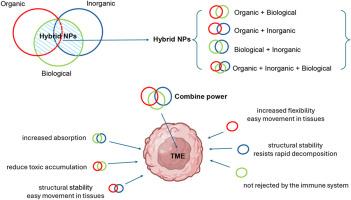Nanoparticles in cancer therapy: Strategies to penetrate and modulate the tumor microenvironment – A review
Q1 Engineering
引用次数: 0
Abstract
Despite advances in conventional cancer treatments such as surgery, chemotherapy, and radiation, these approaches still face significant challenges, including systemic toxicity, limited tumor specificity, and therapy resistance. These limitations highlight the need for more effective, targeted therapeutic strategies. Nanotechnology has emerged as a promising solution in oncology, offering enhanced drug delivery, improved therapeutic efficacy, and reduced side effects. Among nanotechnology-based approaches, nanoparticle-based systems have gained clinical interest due to their biocompatibility, stability, and safety. Although various studies have investigated inorganic, organic, biological, and hybrid nanoparticles, existing reviews often focus solely on individual types, lacking direct comparisons of their performance regarding tumor penetration, controlled drug release, toxicity profiles, therapy resistance, and immune evasion capabilities. This review provides a comprehensive comparative analysis of these nanoparticle systems within the context of tumor microenvironment barriers. It also discusses critical challenges in clinical translation and highlights emerging hybrid platforms that integrate the advantages of multiple nanoparticle types, offering promising strategies for advancing cancer nanotherapy.

纳米粒子在癌症治疗中的应用:穿透和调节肿瘤微环境的策略综述
尽管传统的癌症治疗方法如手术、化疗和放疗取得了进展,但这些方法仍然面临着重大的挑战,包括全身毒性、有限的肿瘤特异性和治疗耐药性。这些局限性突出表明需要更有效、更有针对性的治疗策略。纳米技术在肿瘤学领域已经成为一种很有前途的解决方案,它可以增强药物传递,提高治疗效果,减少副作用。在基于纳米技术的方法中,基于纳米粒子的系统由于其生物相容性、稳定性和安全性而获得了临床的兴趣。尽管对无机纳米粒子、有机纳米粒子、生物纳米粒子和混合纳米粒子进行了各种各样的研究,但现有的综述往往只关注单个类型,缺乏对它们在肿瘤穿透、药物释放控制、毒性、治疗耐药性和免疫逃避能力方面的性能的直接比较。这篇综述提供了肿瘤微环境屏障背景下这些纳米颗粒系统的全面比较分析。它还讨论了临床转化中的关键挑战,并强调了整合多种纳米颗粒类型优势的新兴混合平台,为推进癌症纳米治疗提供了有希望的策略。
本文章由计算机程序翻译,如有差异,请以英文原文为准。
求助全文
约1分钟内获得全文
求助全文
来源期刊

Smart Materials in Medicine
Engineering-Biomedical Engineering
CiteScore
14.00
自引率
0.00%
发文量
41
审稿时长
48 days
 求助内容:
求助内容: 应助结果提醒方式:
应助结果提醒方式:


